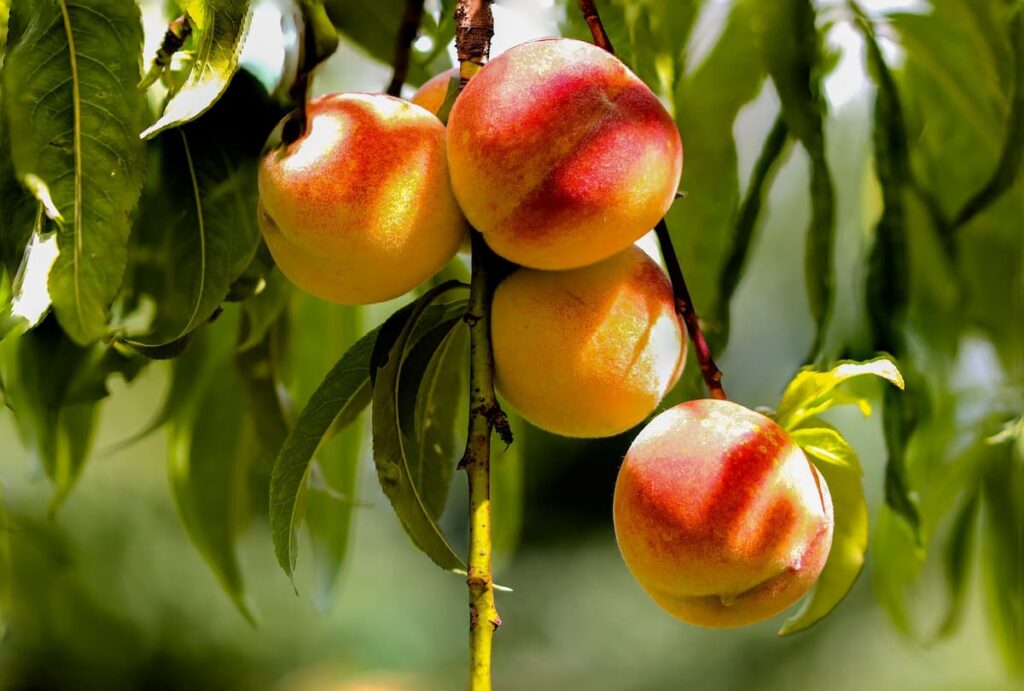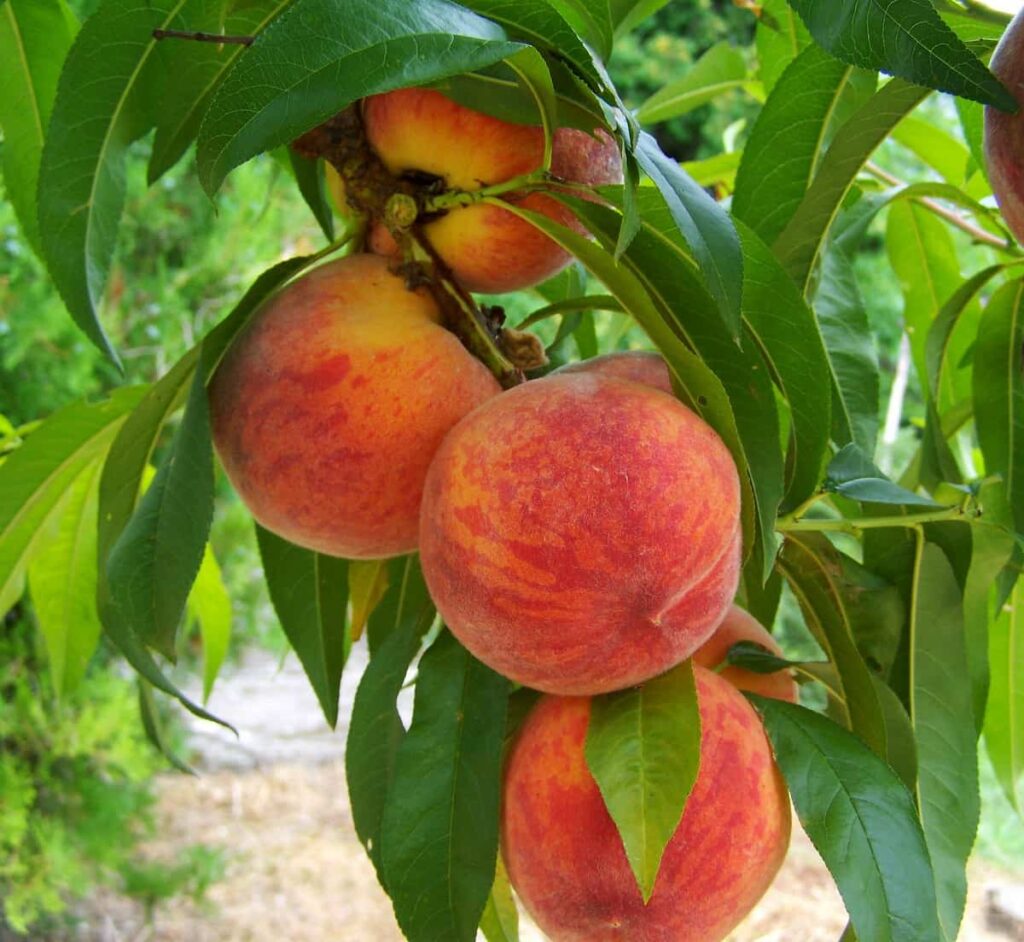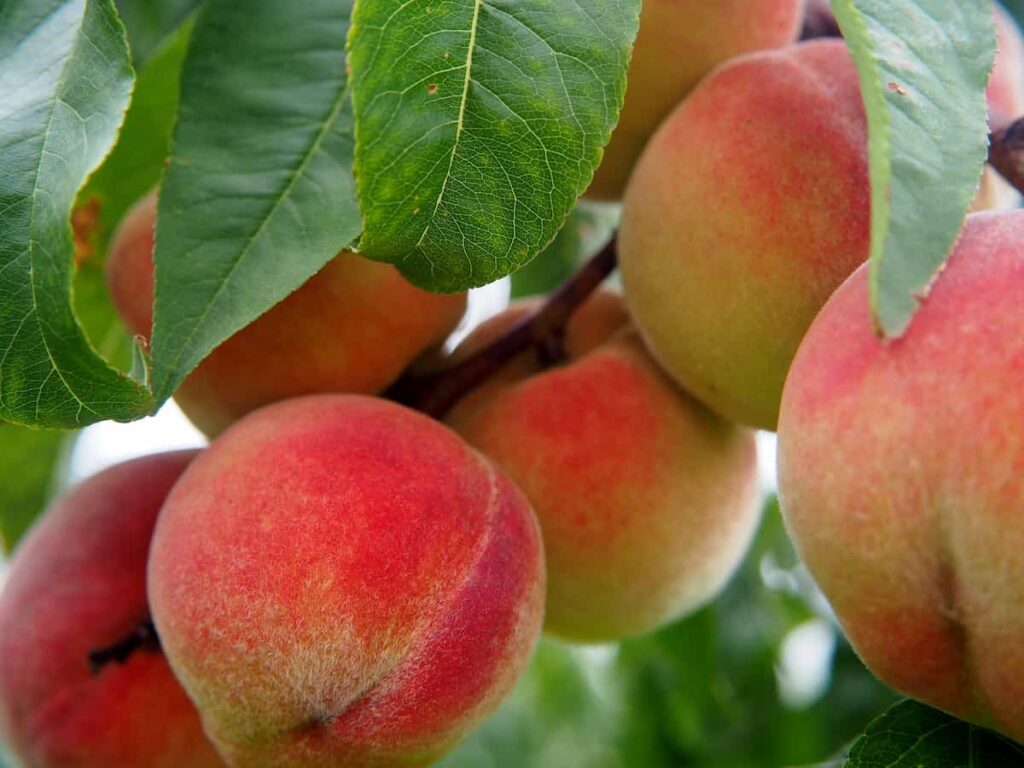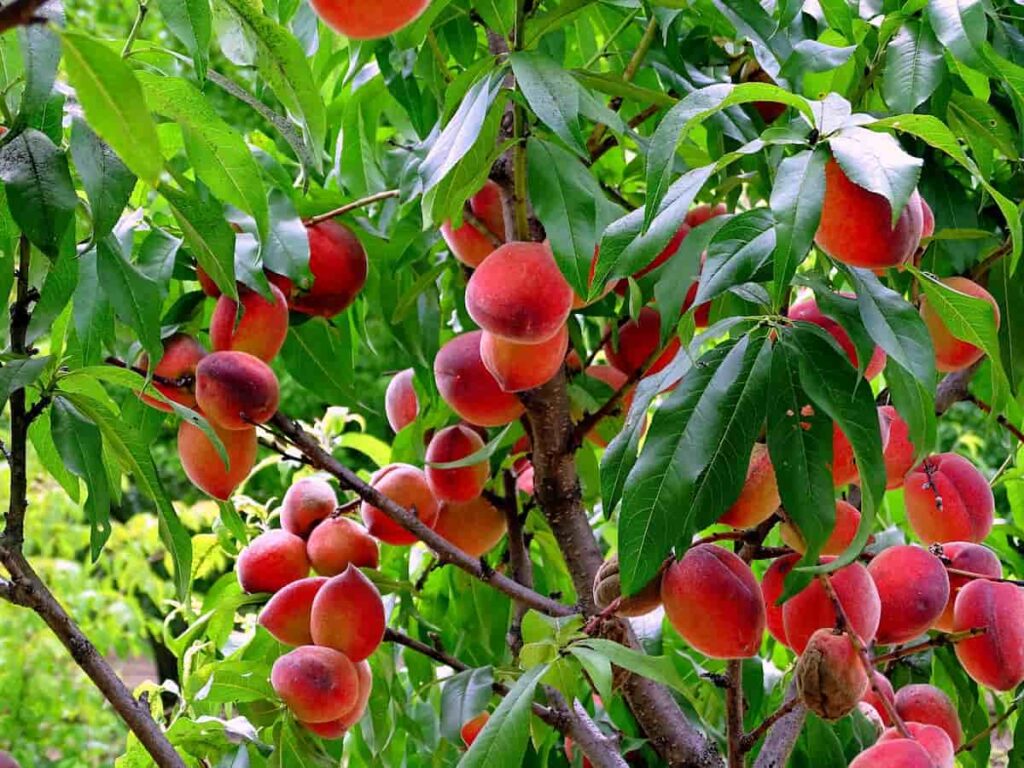A mature Peach tree is a wonderful addition to any landscape. If you’ve decided to grow your Peach tree, you must do a few things to get the biggest Peach tree. Peach trees need regular care throughout the planning stages and growing season if you want to produce large fruits. You can add sweet Peaches inexpensively to your garden by planting trees from seeds.

Choose fully ripened Peaches on the market at the end of summer, eat Peaches and save pits for autumn planting. While seed planting takes longer than planting a young tree from the nursery, savings add up, especially if you want to plant more than one plant.
How to grow Peach from seed to harvest
Germinating Peach seed
- Carefully open a Peach pit and remove the kernel. You can plant the entire pit without opening it first, but the seed germinates faster when the outer shell of the pit is removed. Place the Peach pit in a plastic bag. Fill the bag with slightly moist potting soil. Seal the bag. Keep the plastic bag in your refrigerator. The refrigerator induces the seed germination process through cold stratification, a method of cold treatment that stimulates winter conditions.
- Check the germination after two to three months. Once the roots of the pit are at least half an inch long, remove the pit from the refrigerator. Put the Peach seeds in a container. Place the seeds in a sunny place and provide enough water to moisten the soil. Move it out in early spring after the last frost.
- Peach seeds should be sprouted between two weeks and three months. Once the Peach seed has completely sprouted into a young plant, you can transplant it into a container. Select a large container at least 12 inches long to allow space to prepare the tap root. To encourage sprouting, you should place it in a warm environment. You should plant the Peach pit about 3 to 4 inches deep and then cover it with about an inch or more straw or similar mulch.
The best time to plant a Peach seed
Remove the pit from the Peach fruit. Wash off any juicy residue and leave them to dry for a few weeks. To encourage germination, you should plant seeds during autumn or winter, a few weeks before the last frost. Plant into 12 inches deep pot or directly into the ground. Should receive 1 inch of rainfall or irrigation per week.
In case you missed it: Best Fertilizer for Peach Trees: Homemade, Organic, Compost, NPK, Liquid, How and When to Apply

What month do Peach trees bear fruit?
A Peach tree can bear fruit in early June. However, you can harvest ripe Peaches later in the summer, in July or August (some late-season varieties bear fruit in September). Peach trees grown from seed can take at least three to four years to produce fruit. Buying a young tree means you can soon enjoy the harvest. Plant your Peach tree during its dormancy in late winter or early spring.
Sun requirement for growing Peach trees
- Make sure you should not plant your Peach tree in the shade of another tree or building. Peach trees need full sun to grow. Make sure you give enough space; the tree can grow up to 15 feet tall and 20 feet wide.
- Peach trees thrive well when they receive full sun and have well-drained, fertile soil. During the growing season, you should give at least 6 to 8 hours of sunlight daily. Lighting is essential for fruit production and quality and helps prevent fungal problems. Peaches grow best in full sunlight and well-drained fertile soil. The planting site should receive daily at least eight hours of direct sunlight. The light is necessary to set the fruit.
How many Peaches does one tree produce?
A Peach tree bears fruit in mid to late summer (June to August), 2 to 4 years after planting. Dwarf varieties bear fruit a year earlier (1 to 3 years after planting), and mature trees bear more fruit. Excess fertilizer, excessive pruning, extreme cold, or lack of chill hours can inhibit fruit production. A bushel of Peaches weighs 23 kg so a mature Peach tree can produce 68 to 136 kg of Peach fruits yearly. Dwarf varieties can produce only 23 to 68 kg, and miniature varieties can produce only 23 kg.
In case you missed it: 14 Best Compost Bins for Home in India: For Indoor, Outdoor, and Kitchen Garden

The best fertilizer for growing Peach trees
- A good fertilizer for Peach trees balances nitrogen, phosphorus, and potassium. A good Peach tree fertilizer is a 10-10-10 fertilizer, but any balanced fertilizer, such as 12-12-12 or 20-20-20, will do. You should not place the fertilizer near the tree trunk when fertilizing Peach trees. This can damage the tree and prevent nutrients from reaching the tree’s roots. Instead, fertilize your Peach tree about 8 to 12 inches from the tree trunk.
- Peach trees need to be fertilized frequently unless you are using fertilizer spikes. Choose spike fertilizer if you only want to fertilize twice a year; otherwise, fertilize your Peach trees every two to three months during the growing season.
Do you prune a Peach tree?
- Ideally, you should prune Peach trees every year in the spring, just as buds swell and begin to turn pink. It’s better to cut a little late than too early. However, you can remove shoots that develop in the middle of the tree at any time, as these will prevent the sun and air from reaching the fruits. You should prune Peach trees as late as possible before blooming in spring. Growers with multiple acres of trees may have to start pruning several weeks before bloom to ensure the work is completed on time.
- Peach trees produce fruit on year-old wood so that a mature tree can be cut extensively. Remove about 40% of the tree each year to encourage new growth after pruning, so there will be branches that thrive each year. Usually, remove old grey shoots as they won’t bear fruit. Summer pruning reduces the dormant pruning required in the first winter and will direct growth in the desired scaffolding branches.
How do I grow bigger Peaches?
- When the branches are overloaded, each fruit gets a small portion. There isn’t enough water and nutrition to go around. The result is a small fruit with hard, moisture-less flesh.
- Fertilize your Peach trees a week after planting. You should fertilize with 0.6 kg of 10-10-10 fertilizer. After planting 40 days, you can apply the same amount to ensure your tree has enough nutrients to produce large Peaches. Water repeatedly and deeply during the last six weeks before harvesting. During this period, Peaches grow rapidly and thrive and grow larger due to the increase in water.
In case you missed it: How to Grow Broccoli in Pots in India: at Home, on the Terrace, in the Backyard and Balcony

Water requirement for growing Peach trees
- You should provide 1 and 1.5 inches of water per week for a mature Peach tree. If there is not enough rain, additional irrigation is required. You should consider watering them deeply two or three times per week. Spreading mulch around the tree at 2 to 4 inches will help save soil moisture. Too much water easily harms the health of Peach trees and can even kill trees. Too much water or continuous rain can lead to brown rot, which is a type of fungus. To prevent it, you can also spray Peach trees with fungicides during the spring blooming season.
- Peach trees don’t need much water every day. However, if you find that your soil or the environment of your location needs to water your Peach trees more frequently to avoid drought stress, adjust your water schedule accordingly. Like any other fruit tree, Peach trees require enough moisture to perform at their best.
Soil requirement for growing Peach trees
- Choose a site with well-drained, moderately fertile soil. Peach trees will not perform well in areas where the soil is compact or is constantly wet. Peaches prefer slightly acidic soil and thrive in lightweight loamy, well-drained soil.
- It’s important not to plant Peach trees in low spots in the landscape where there are pools of water, as this can cause problems such as root rot, which can lead to the death of your tree. You can use any commercial potting soil to grow fruit trees. However, mixing 1 part sand, 1 part peat, and 1 part bark, perlite, or vermiculite will serve quite well.
How many years does it take for a Peach tree to bear fruit?
The average age of the Peach tree is 12 years. Unlike permanent crops that last 40 years, Peach trees only last 12 years. A significant branch spread can indicate the tree’s age even if your tree has been cut down. Maximum fruit production begins at about six years old and continues for 12 years. When growing a Peach tree from seed, it takes three to four years to produce fruit; choose a variety of Peach trees growing in your climate.
Do Peaches grow true to seed?
Peaches come true to seeds, meaning the seed-grown tree will generally be similar to the parent tree and bear similar fruit. Although commercial gardens plant grafted Peach and apricot trees, a seed tree is a great option for a yard or community garden.
In case you missed it: How to Start a Water Garden: A Step-by-Step Guide for Beginners

Growing Peach tree in a pot
- Peaches bloom in early March, so growing Peaches in the container make protecting the tree from sudden frost or winds easier. The root system of the Peach tree in the ground can grow from 10 to 20 feet in the ground. Natural dwarf Peaches will be slightly shallower, but they can still grow several feet long.
- You can use a 15-gallon pot, as they can usually hold five-foot tall trees. Peach trees perform well in a large porous terracotta pot or ultra-heavy concrete. The bottom of the pot you choose needs to have several drainage holes. Gravel and trays will work together to ensure drainage holes can work effectively.
How do you tell if a Peach is ripe for picking?
Peaches ripen three to five months after flower pollination. Ripe Peaches will lose their green firmness. They give slightly when squeezed you slowly. You can check the firmness of the ripe Peach fruit while it is still on the tree. When you squeeze them, Peach fruits are still hard; they need more time to ripen on the tree. Check back in a few days.
In case you missed it: How to Grow Pears from Seed to Harvest: Check How this Guide Helps Beginners

Do Peaches get sweeter after picking?
Unlike some other fruits, Peaches won’t produce a sweet, juicy flavor after being selected from the tree. So, once a raw Peach is picked up and taken to a grocery store, it will never meet your expectations.
How deep are the roots of a Peach tree?
The roots of Peach trees are relatively shallow, as they are not invasive. Peach tree roots are usually only a few feet deep in loose soil but can spread up to three feet or more. If you want a good harvest, cut the branches each year after growing to about 10 feet. Peach trees need at least 10 feet of space for their canopy and another 20 feet for their roots to spread.
Conclusion
Peach fruits have a large stone pit in the center. And inside this pit is a Peach seed. This seed can be extracted from the pit and planted to become a brand-new Peach tree. You must remove and prepare it before you can plant the Peach seed. You can easily plant Peach seeds by using seed pits preserved from used fruits and germinating them in the right conditions. The sweetest and juicy Peach you’ll ever taste can be picked up from your tree. When harvested at the peak of ripening, backyard Peaches are filled with nature’s sweet gifts with no concerns about shelf stability or long transportation. There are wide easy-to-grow Peach varieties.
- How to Grow Hibiscus from Flower
- Plantation Ideas for Home Decoration: A Beginners Guide
- Flower Garden Designs and Layouts for Beginners
- Planting and Spacing Techniques in Papaya: A Beginner’s Guide
- Growing Gold: Essential Techniques for Planting Pineapples
- How to Make Kalanchoe Plant Bushy: Home Remedies and Solutions
- 11 Reasons Why Your Gardenia is Not Blooming: Home Remedies and Solutions
- Eco Elegance: The Guide to Designing a Drought-Tolerant Landscape
- Gardening on a Slope: Strategies for Hillside Landscaping
- Nourish and Flourish: Top Organic Mulches for Thriving House Plants
- Everything You Want to Know about Indian Mogra Flower: Discover Uses and Growing
- Green Thumb Success: Expert Tips for Cultivating Greenhouse Pumpkins All Year Round
- Maximize Growth & Flavor: The Ultimate Guide to Companion Planting in Herb Gardens
- How to Control Rhododendron Problems Naturally: Home Remedies and Organic Ways to Fix Them
- Natural Magic: The Remarkable Benefits of Cinnamon for Plants
- Best Steps to Revive Dying Tulip with Natural and Organic Treatment
- 10 Reasons Why Your Angel Trumpet is Not Blooming: Remedies and Treatment
- How to Fix Periwinkle Leaf and Flower-Related Problems: Natural Remedies and Solutions
- How to Fix Zinnias Leaf and Flower Problems: Discover Natural and Home Remedies
- Organic Steps to Induce Lemon Tree Flowers: A Comprehensive Guide
- Bloom Booster: Crafting the Perfect Homemade Bougainvillea Fertilizer
- Optimizing Growth: A Guide to Applying NPK Fertilizer for Potted Plants
- 10 Best Homemade Fertilizers for Rubber Plant: DIY Recipes and Application Method
- How to Boost Female Pumpkin Flowers: Effective Steps for More Flowers and High Yields
- Transform Your Indoor Garden: Top Benefits of Pink Salt for Houseplants
- 10 Best Homemade Fertilizers for Peacock Plants (Calathea): Easy DIY Guide
- Unlock Blooms: 9 Reasons Why Your Potted Chrysanthemum is Not Blooming
- 8 Reasons Why Your Potted Hibiscus is Not Blooming: Fix it with Simple Solutions
- Unlock Blooms: 9 Key Reasons Your Potted Frangipani Won’t Flower
- 10 Reasons Why Is My Ice Plant Not Blooming: Remedies and Treatment
- 10 Reasons Why My Potted Hydrangea Not Blooming: Treatment and Remedies
- 10 Reasons Why is My Wisteria Not Blooming: Remedies and Treatment
- 10 Reasons Why is My Goldfish Plant Not Blooming: Remedies and Treatment
- Maximize Your Space: Ultimate Guide to Balcony Gardening with Grow Bags
- 10 Reasons Why Your Iris is Not Blooming: Remedies and Treatment
- 10 Reasons Why Your Anthurium Plant is Not Blooming: Treatment and Remedies